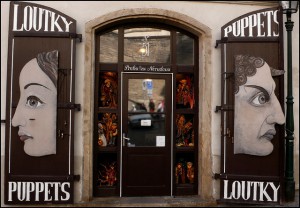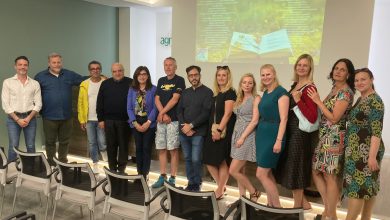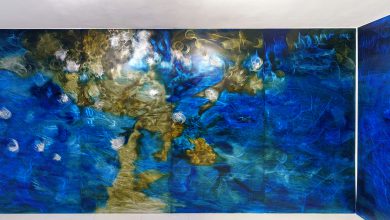
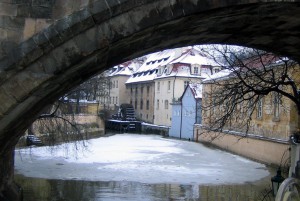 At seven in the morning Charles Bridge is still deserted, whether shrouded in the cold autumn and winter morning mist, or in the alluring colours and the warm air of the spring and summer. It is true that in spite of Prague being one of the most touristic cities of Europe, the tourists all go to the same places at the same time. This is indeed the best time to enjoy all the charm of the unrivaled architectural wonder in solitude, the construction of which, was wanted by the Emperor Charles IV, and is shrouded in legend. The Stone Bridge as it was named until 1870, the year in which it took its present name, was built on the ruins of the older Judith Bridge, from the twelfth century, which was destroyed by the Vltava river flooding in 1342. The ancient ruins of the bridge are still preserved in the lobby of the Residence Lundborg, number 3 on the street U lužického semináře. An interesting feature that reveals Emperor Charles IV’s passion for the esoteric, is found in the numbers related to the date of its construction. It is said that the Emperor himself wished to symbolically lay the foundation stone on July 9, 1357 at 5:31 minutes, due to a favorable astral conjunction. It is therefore unsurprising, that the number 135797531 which summarizes the exact date and time of the start of this construction is a palindromic number, and is therefore magical.
At seven in the morning Charles Bridge is still deserted, whether shrouded in the cold autumn and winter morning mist, or in the alluring colours and the warm air of the spring and summer. It is true that in spite of Prague being one of the most touristic cities of Europe, the tourists all go to the same places at the same time. This is indeed the best time to enjoy all the charm of the unrivaled architectural wonder in solitude, the construction of which, was wanted by the Emperor Charles IV, and is shrouded in legend. The Stone Bridge as it was named until 1870, the year in which it took its present name, was built on the ruins of the older Judith Bridge, from the twelfth century, which was destroyed by the Vltava river flooding in 1342. The ancient ruins of the bridge are still preserved in the lobby of the Residence Lundborg, number 3 on the street U lužického semináře. An interesting feature that reveals Emperor Charles IV’s passion for the esoteric, is found in the numbers related to the date of its construction. It is said that the Emperor himself wished to symbolically lay the foundation stone on July 9, 1357 at 5:31 minutes, due to a favorable astral conjunction. It is therefore unsurprising, that the number 135797531 which summarizes the exact date and time of the start of this construction is a palindromic number, and is therefore magical.
The 516 metres long Bridge, designed by the German architect Peter Parléř, links the district of Staré Město with Malá Strana, literally “small side”, on the other side of the Vltava river and constitutes the most immediate access route. One of the major attractions of the Gothic bridge, are certainly its 30 Baroque statues which were erected in the seventeenth century on the pillars of both sides at the behest of the Jesuits. The subjects depicted, all belong to the Catholic tradition and served as effective propaganda in the period of the Counter-Reformation, but this juxtaposition of different styles was not appreciated by the great sculptor Auguste Rodin when he visited Prague for the first time. The statues visible today, are all copies of the originals.
Approaching the end of the bridge, on the Malá Strana side, stone stairs allow access to the elegant 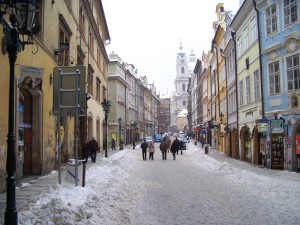 square of Kampa Island, with its noble looking buildings, each of which boasts numerous anecdotes, legends and mysteries. We are in one of the most romantic and fascinating parts of the city. The park of this island offers a spectacular view of the river and the Old Town on the other side, where the majestic dome of the National Theatre stands. Kampa Island is separated from the rest of Malá Strana by an artificial canal built in the twelfth century by the Knights of Malta, whose commandry, among the most beautiful in the world, is located on this island. The channel is called “Čertovka”, the “channel of the Devil”, a name that speaks volumes about the air of mystery that surrounds this part of Prague, and helped create the reputation of a magical city which the Bohemian capital boasts. However, not all the strange stories of this place are legendary. On Kampa island, the first Masonic lodge in Prague came to light, called “Les trois cannons”, an itinerant lodge founded by officers of the French army in the eighteenth century. It is certainly no coincidence that the Knights of Malta too, a long time before, had already chosen this place as their residence. Regarding the alleged esoteric tradition of this city however, too much has been said and written. One must let the reader judge in what proportion are truth and fantasy mixed, maybe while watching the sun from the Charles Bridge on the day of the Summer Solstice, the only day of the year when the star sets exactly (must it not be a coincidence) behind the Castle.
square of Kampa Island, with its noble looking buildings, each of which boasts numerous anecdotes, legends and mysteries. We are in one of the most romantic and fascinating parts of the city. The park of this island offers a spectacular view of the river and the Old Town on the other side, where the majestic dome of the National Theatre stands. Kampa Island is separated from the rest of Malá Strana by an artificial canal built in the twelfth century by the Knights of Malta, whose commandry, among the most beautiful in the world, is located on this island. The channel is called “Čertovka”, the “channel of the Devil”, a name that speaks volumes about the air of mystery that surrounds this part of Prague, and helped create the reputation of a magical city which the Bohemian capital boasts. However, not all the strange stories of this place are legendary. On Kampa island, the first Masonic lodge in Prague came to light, called “Les trois cannons”, an itinerant lodge founded by officers of the French army in the eighteenth century. It is certainly no coincidence that the Knights of Malta too, a long time before, had already chosen this place as their residence. Regarding the alleged esoteric tradition of this city however, too much has been said and written. One must let the reader judge in what proportion are truth and fantasy mixed, maybe while watching the sun from the Charles Bridge on the day of the Summer Solstice, the only day of the year when the star sets exactly (must it not be a coincidence) behind the Castle.
The Tower located at the end of the bridge, on the side of Malá Strana, dates back to the Judith Bridge era, and is the gateway to the neighborhood itself.
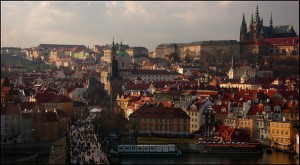 Malá Strana was created by the Přemyslid king Ottokar II in 1257. Following the Hussite wars and the numerous fires that the neighborhood has suffered over the course of its long history, the wooden houses were gradually replaced by beautiful Renaissance buildings built by Italians, who from the second half of the sixteenth century, were coming to Prague to work in the construction sites of the Castle and the villas of the nobility. From the Italians who settled in this district, which was first inhabited mainly by Germans, important traces still remain: the building of the Italian Institute of Culture in Prague, which dates back to the seventeenth century, once the hospital of the Italian Congregation founded in 1573. Later, in the eighteenth century, Baroque style prevailed in the district, giving birth to architectural works such as the prestigious Lobkowicz Palace at no. 19 Vlašská Street, the reverse side of which is a true masterpiece. The area, once independent, was united with the other municipalities of the city of Prague by the Emperor Joseph II on February 12, 1784.
Malá Strana was created by the Přemyslid king Ottokar II in 1257. Following the Hussite wars and the numerous fires that the neighborhood has suffered over the course of its long history, the wooden houses were gradually replaced by beautiful Renaissance buildings built by Italians, who from the second half of the sixteenth century, were coming to Prague to work in the construction sites of the Castle and the villas of the nobility. From the Italians who settled in this district, which was first inhabited mainly by Germans, important traces still remain: the building of the Italian Institute of Culture in Prague, which dates back to the seventeenth century, once the hospital of the Italian Congregation founded in 1573. Later, in the eighteenth century, Baroque style prevailed in the district, giving birth to architectural works such as the prestigious Lobkowicz Palace at no. 19 Vlašská Street, the reverse side of which is a true masterpiece. The area, once independent, was united with the other municipalities of the city of Prague by the Emperor Joseph II on February 12, 1784.
Malá Strana today includes parts of the Municipalities of Prague 1 and 5, has about 7,000 inhabitants and covers an area of just 1.37 square kilometers, but few other places in the world can boast such an abundant number of works of art and architecture in such a limited space.
Its unique architecture, countless streets, narrow passages and hidden gardens in the courtyards of its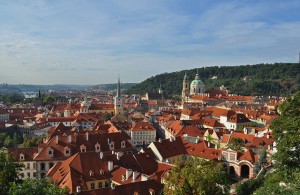 palaces make this area one of the most beautiful places in Europe. To enumerate all the architectural beauty of Malá Strana and the stories related to it would require an entire monograph, and there are in fact, many books written on the neighborhood. It is interesting to mention some places in Malá Strana here that are not normally referred to in the guidebooks, but are by no means to be considered less interesting. Not far from the Commandry of the Knights of Malta, at no. 8 in the square named after them, is an old building, once a hotel, where Rainer Maria Rilke stayed, and then the brothel frequented by the writer Franz Kafka.
palaces make this area one of the most beautiful places in Europe. To enumerate all the architectural beauty of Malá Strana and the stories related to it would require an entire monograph, and there are in fact, many books written on the neighborhood. It is interesting to mention some places in Malá Strana here that are not normally referred to in the guidebooks, but are by no means to be considered less interesting. Not far from the Commandry of the Knights of Malta, at no. 8 in the square named after them, is an old building, once a hotel, where Rainer Maria Rilke stayed, and then the brothel frequented by the writer Franz Kafka.
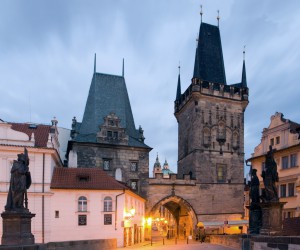 Adjacent to the square of Malostranské náměstí in the heart of the neighborhood, once called “the Square of the Italians”, at number 2 on Tomášská street there is still the favorite inn of the Austrian, Prague-based writer Gustav Meyrink, mentioned in his famous novel “Walpurgis Night”, where even the Tsar Peter the Great stayed, who particularly loved the beer produced there. Not far away, on Letenská street, there is the little-known Church of St. Thomas, a gothic church remodeled in Baroque style, full of decorations despite its small size. A place to see after visiting the more famous churches of St. Nicholas and Our Lady of Victory, which houses the miraculous wax statue of the Child Jesus, visited by thousands of pilgrims every year. Going down Neruda Street and ignoring the many souvenir shops of questionable taste to tourists, each building has its own story, with its own picturesque insignia, the spectacular facades and the story of those who once inhabited them. One in particular however, less well-known than others such as “At three violins” at no. 12, or like the Thun-Hohenstein Palace, headquarters of the Italian Embassy at n. 20, deserves special attention. It is an inconspicuous building, located at no. 19. Its history dates back to 1253, the era of the constructions of the old walls of the neighborhood. This place was exactly where the Strahov Gate was found, also known as Hansturkovská, a fortified access point wanted by Ottokar II. The door still existed in 1711 and it separated Malá Strana from Hradčany and Strahov. In 1611 the mercenaries of Matthias von Habsburg passed through this passage to enter Malá Strana and sacked the neighborhood. The soldiers of Ferdinand II invaded the city too, in 1620, also through this passage.
Adjacent to the square of Malostranské náměstí in the heart of the neighborhood, once called “the Square of the Italians”, at number 2 on Tomášská street there is still the favorite inn of the Austrian, Prague-based writer Gustav Meyrink, mentioned in his famous novel “Walpurgis Night”, where even the Tsar Peter the Great stayed, who particularly loved the beer produced there. Not far away, on Letenská street, there is the little-known Church of St. Thomas, a gothic church remodeled in Baroque style, full of decorations despite its small size. A place to see after visiting the more famous churches of St. Nicholas and Our Lady of Victory, which houses the miraculous wax statue of the Child Jesus, visited by thousands of pilgrims every year. Going down Neruda Street and ignoring the many souvenir shops of questionable taste to tourists, each building has its own story, with its own picturesque insignia, the spectacular facades and the story of those who once inhabited them. One in particular however, less well-known than others such as “At three violins” at no. 12, or like the Thun-Hohenstein Palace, headquarters of the Italian Embassy at n. 20, deserves special attention. It is an inconspicuous building, located at no. 19. Its history dates back to 1253, the era of the constructions of the old walls of the neighborhood. This place was exactly where the Strahov Gate was found, also known as Hansturkovská, a fortified access point wanted by Ottokar II. The door still existed in 1711 and it separated Malá Strana from Hradčany and Strahov. In 1611 the mercenaries of Matthias von Habsburg passed through this passage to enter Malá Strana and sacked the neighborhood. The soldiers of Ferdinand II invaded the city too, in 1620, also through this passage.
The ruins of this ancient fortification are still visible in the basement of this historic building where the music video of “Žiletky”, from the Czech underground band Psí vojáci was filmed.
by Mauro Ruggiero

